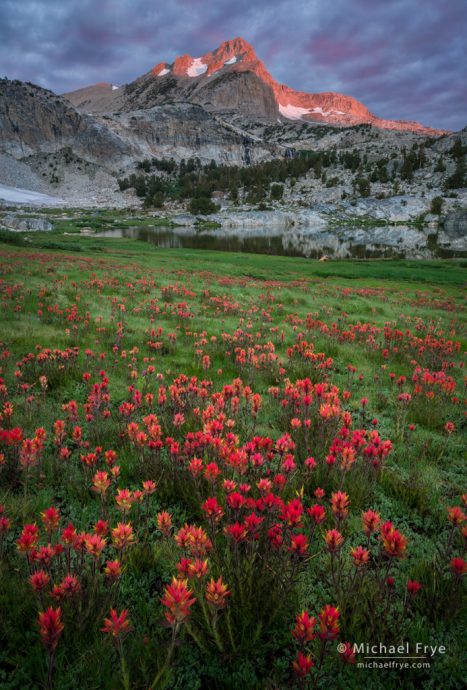
Paintbrush and peak, sunrise, Inyo NF, California. Since the closest flowers were only a foot from the camera, I used focus-stacking to get everything in focus, blending five frames with Helicon Focus. (Exposures were 1.5 seconds at f/16, ISO 100, focal length was 23mm.)
Last winter was a strange one in the Yosemite area, with most of the precipitation coming in March, followed by a big, warm rainstorm in early April that created flooding in Yosemite Valley. That rainstorm melted much of the snowpack below 9,000 feet, so spring came early in those low- and mid-elevation areas. We found some nice flower displays at those elevations, but nothing exceptional.
Above 9,000 feet, however, the snowpack remained intact, even after the early-April flood. And that lingering snow led to an exceptional bloom in the highest elevations. Back in July, before the fires, Claudia and I photographed the flowers as much as we could, and we also led our Range of Light workshop group to a couple of our favorite flower spots.
In one area we found an abundance of hybrid columbines. The larger alpine columbines are typically found in rocky areas from 9,000 to 13,000 feet. Their smaller cousins, called crimson columbines, live along streams and in other moist areas between 4,000 to 10,000 feet. Where their ranges overlap they interbreed.
The hybrids usually take on the size and shape of the alpine columbines, with colors ranging between the red-and-yellow crimson columbines and the cream-colored alpine columbines, which often results in a beautiful mix of pale yellow and salmon pink. Claudia and I spent an afternoon happily photographing these hybrids, and even found one spot where they were mixed with purple heather and yellow western wallflowers.
We also found some dense patches of paintbrush, as you can see in the photograph at the top of this post, and other locations with colorful blends of many different species.
As often happens with flowers, many of these images required focus stacking to keep everything sharp, or to throw the background out of focus while making all of the flowers sharp. You can learn more about focus-stacking here.
Alas, the flower season is always too short, and most of the flowers are gone from even the highest peaks now. But we had fun photographing them while they lasted.
— Michael Frye
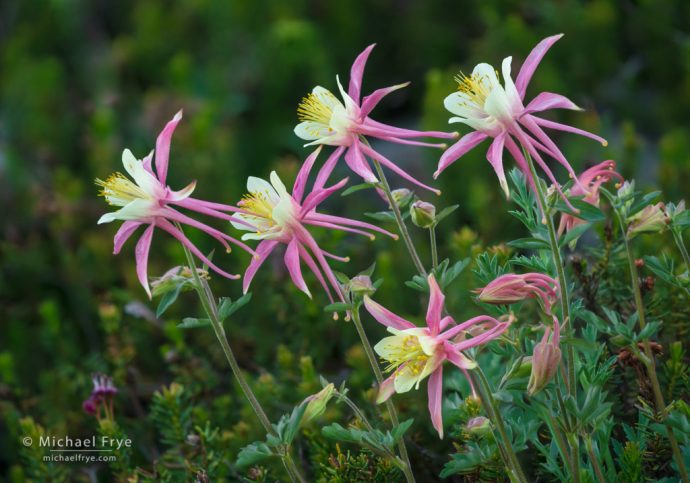
Alpine-crimson columbine hybrids, Inyo NF, California. Another focus-stack, this time of eight frames, each at 1/20th of a second at f/5.6, ISO 400. The focal length was 200mm. I used the relatively wide aperture to keep the background out of focus, while the focus-stacking kept all of the columbines sharp.
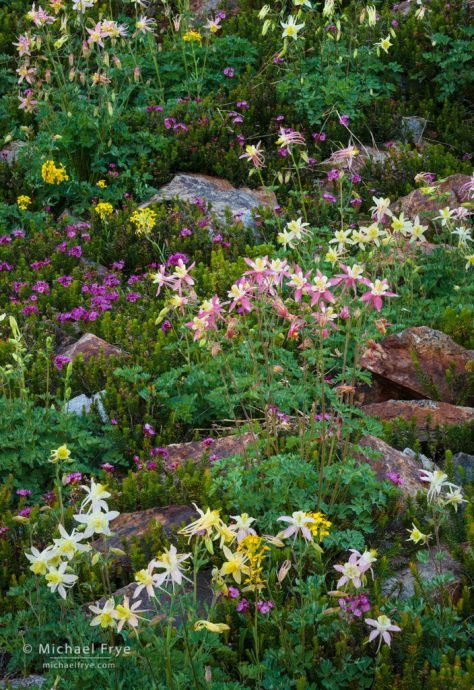
Wildflower mix, Inyo National Forest – alpine columbines, alpine-crimson columbine hybrids, yellow western wallflowers, red mountain heather. You can see some cream-and-pale-yellow alpine columbines in the lower-left corner, with pale-pink hybrids just to their right, and more deeply-colored hybrids in the middle. Another focus stack, this time four images taken at 1/6 of a second at f/16, ISO 200, with a focal length of 120mm.
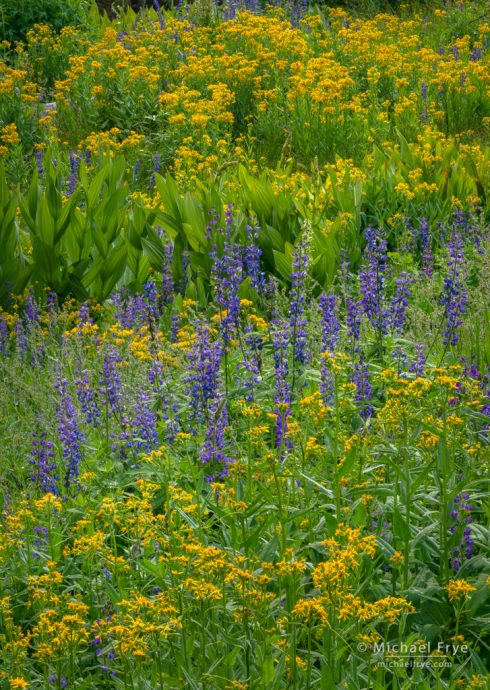
Lupines, arrowhead butterweed, and corn lilies, Yosemite. Yes, this is another focus stack, of five images taken at 1/4 of a second, f/16, ISO 100, 176mm.
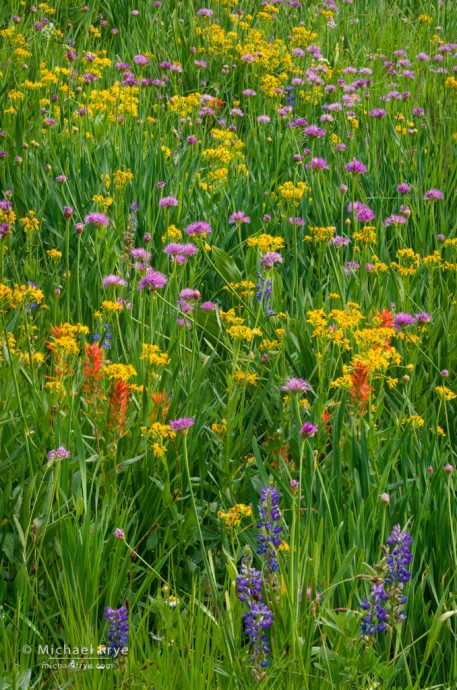
Paintbrush, wild onions, lupines, and arrowhead butterweed, Yosemite. A focus stack of five images taken at 1/4 of a second, f/16, ISO 100, 135mm.
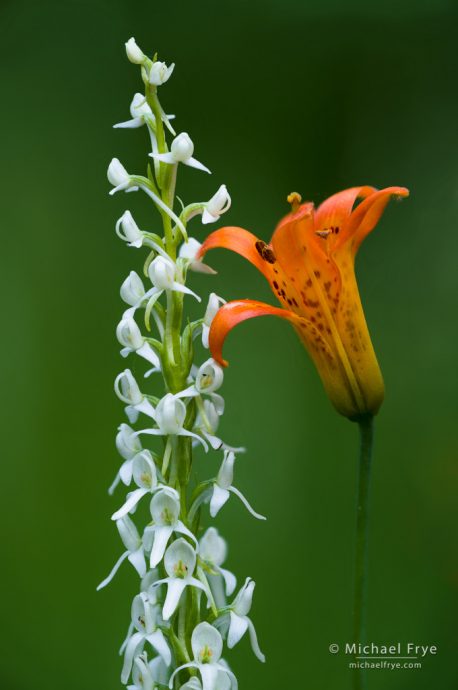
Sierra rein orchid and Sierra tiger lily, Inyo National Forest. This is another wide-aperture focus-stack to keep the flowers (mostly) sharp and throw the background out of focus. 15 frames taken at 1/45th of a second at f/5.6, ISO 100, 97mm.
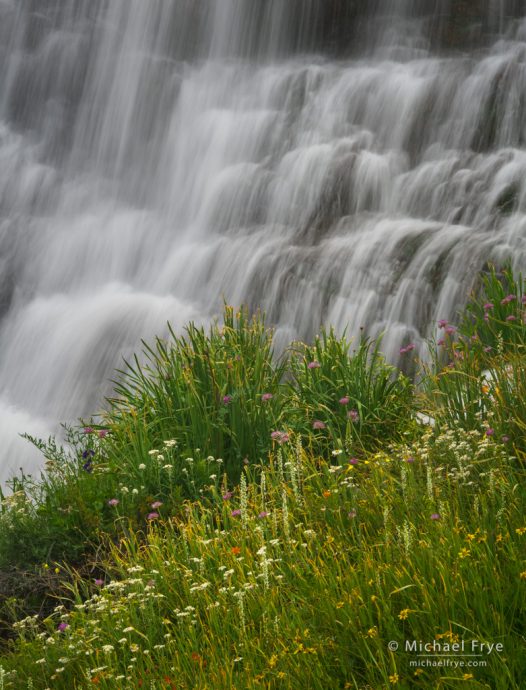
Wildflowers and waterfall, Inyo National Forest. Not a blend – just one frame! 1/6 second at f/16, ISO 200, 187mm.
Related Posts: Rebirth; Summer Wildflowers; Focus-Stacking Season
Michael Frye is a professional photographer specializing in landscapes and nature. He is the author or principal photographer of The Photographer’s Guide to Yosemite, Yosemite Meditations, Yosemite Meditations for Women, Yosemite Meditations for Adventurers, and Digital Landscape Photography: In the Footsteps of Ansel Adams and the Great Masters. He has also written three eBooks: Light & Land: Landscapes in the Digital Darkroom, Exposure for Outdoor Photography, and Landscapes in Lightroom: The Essential Step-by-Step Guide. Michael has written numerous magazine articles on the art and technique of photography, and his images have been published in over thirty countries around the world. Michael has lived either in or near Yosemite National Park since 1983, currently residing just outside the park in Mariposa, California.

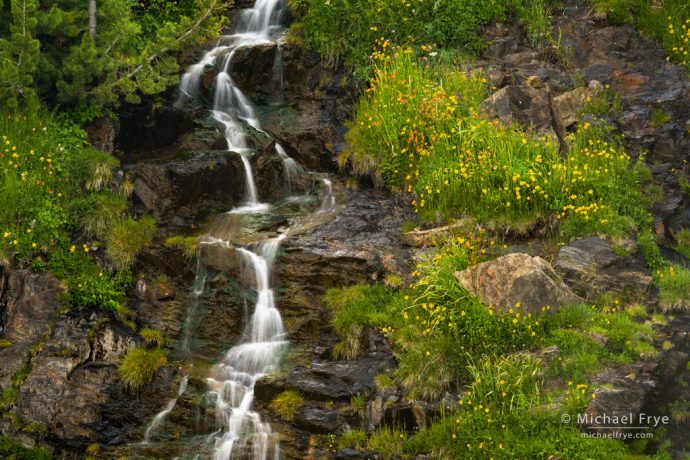








Wow Michael, those columbine images are gorgeous
Thank you Felicia!
lovely nature photos.
Thanks Merrily!
So beautiful totally pulls me in. Are prints available?Thank you Dennette
Thanks Dennette! Yes, prints are available for almost every image on my site. You can see sizes and prices here:
https://www.michaelfrye.com/portfolios/print-ordering/
Beautiful shots Michael. I just wish so many of those kind of shots didn’t require focus stacking. 🙂
Thanks John! I look at it differently – I’m thankful that I can focus-stack and get everything in focus, which allows me to make compositions I wouldn’t otherwise be able to make. 🙂
Thank you for sharing your wonderful images. One day I hope to see the spring mountain flowers IRL. You do such amazing work.
Thanks Terry!
Beautiful shots. You have focus stacking shots from 4-15 exposures. Do you have a method to determine the number of shots required?
Thanks John. The number of shots required depends on the aperture and how much depth you have. If I’m shooting at a wide aperture to throw the background out of focus, as I did in a couple of the closeup photographs here, then the depth of field is very shallow, so in order to get all of a flower or clump of flowers in focus you have to change your focus in tiny increments, and thus you’ll have to make many exposures. If I’m trying to get everything in focus, and can’t do that even at f/16 or f/22, then I’ll typically shoot at f/16, which gives me a lot more depth of field, and a lot of overlap in focus between frames, so I typically don’t need as many frames. The post I link to here about focus stacking describes my basic procedure for all this.
I’d like to hiking to first picture paintbrush shot(gorgeous!) area , on tomorrow morning.
Please send me information of location.
Thanks Much.
714-315-9798